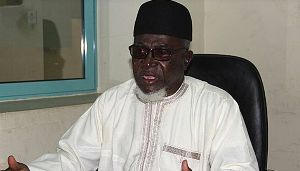Nat Nuno Amarteifio and Joe Osae Addo are two architects who have embarked upon a rare mission in Accra and beyond. They want to protect the heritage of the city to which they belong spiritually and physically and what better way to do this than embark on a project to present the history of the city in simple and therefore comprehensible manner to both the sophisticated minds and otherwise.
That is but only a fragment of the gigantic project their organization, ArchiAfrika Initiative is embarking upon not only in Accra but across West Africa.
On 26TH February 2016 they hosted an exhibition on the history of Jamestown at the historic Tarquah House next door to the first shopping centre in Accra the 1914 built Kingsway Shop.
ArchiAfrika according to Joe Addo “is a collective of creatives committed to broadening the development discourse to include ‘Growth Underpinned by Creativity.”
“Our next exhibition will be in Senegal for the DAK’ART biennale in June” Joe Addo said.
The February exhibition was preceded by a 2015 series of initiatives in Jamestown dubbed ‘The Old City’.
It was intended to promote as Joe Addo said “the idea of integration over erasure as an approach to development.” It was supported by the Kingdom of the Netherlands Embassy in Ghana with Nigerian Architect Kunle Adeyemi in action at the locally renowned Old Kingsway Building. It was an evening of Music, Poetry and Architecture hosted in partnership with the community that was a highlight of the Accra Revisited Urban Design Conference.
In the following months, ArchiAfrika has continued to engage with the Jamestown community, with a film night at Ussher Fort and other initiatives and as Joe Addo said “we now seek to create a permanent base in the community with whom we are working, the motivating factor behind the creation of our new Design + Architecture Gallery.”
The first official opening event was a soft opening of sorts as Chairman Joe Osae-Addo said “to introduce ArchiAfrika and friends to our new community and family in our new home, coinciding with the renowned Berlage Institute Students’ visit that we are hosting as part of ArchiAfrika Chairman Joe Osae-Addo’s role of Berlage Visiting Lecturer.
James Town1
Nat and Joe Addo flanked by their guests
The highlight of the engagement was the exhibition on the history of Jamestown by architect, historian and former Mayor of Accra, Nat Nuno Amarteifio. It was the latest in ArchiAfrika’s contributions to the archiving and development of the Old City.
The new Gallery is situated in Tarquah House, a former department store built next to the site of the Old Kingsway Building constructed in 1915. Recent years have seen the structure house families and businesses, and now will become “the base of our next phase in Jamestown, which will see us plug into the ‘every day’ with initiatives that contribute to local development.”
I visited the exhibition and learnt a lot. It was an evening of; as Joe Addo said: “of connecting, networking and history over refreshments”.
The exhibition was arguably the first of its kind about the nucleus of Accra, Jamestown; the venue itself being auspicious.
In his narration at the exhibition, one-time Mayor of Accra, Architect Nat Amarteifio told his attentive audience that the street on which the exhibition was being held used to be the Oxford Street of Accra in the olden days.
The Jamestown Kingsway was the first modern shopping centre in Accra, property of the United Africa Company (UAC) which was later relocated to its final spot where it took its last breath.
Those who visited the exhibition lapped the contents of the hall with visible gusto listening attentively as Nat made his narration about the city whose history many have not bothered to learn.
It was commendable that the indigenous architects true to their professional calling decided to rush to salvage the history of Accra lest it is rendered inaccessible by generations yet unborn.
The exhibition hall was enough to contain the reader-friendly history of the Gas and their relationships with the earlier European traders.
It was fascinating reading about how the Gas originated from the lower banks of the Volta River and moved in family or clan groups until their permanent settlement in hills overlooking the Accra Plains.
Nat had earlier told us about how the Dutch weaponry offered a ready protection to the Gas who were compelled to flee the Ayawaso area, far away from the Atlantic Ocean, from a more powerful ethnic group. Today, as he put it, the final ritual involved in the enstoolment of Ga Kings is undertaken at a place close to the Ussher Fort, away from human predators.
I could not subdue the urge to read on and regretted that I did not take writing material to take adequate notes about ‘Jamestown the face of Accra in the latter part of the 1800s.’
The Accra plains were dotted with lagoons and rivers rich in fish and salt resources which alongside agriculture formed the basis for the dominant peasant economy at the time.
The Gas established a trading link with nations in the hinterland especially the forest belt such as the Akwamus, Akyems and later the Asantes with whom they exchanged gold, slaves and forest products.
The turning point in the history of the Gas came in the 15th Century when the first group of Portuguese landed on their coast and began exchanging alcohol, textiles and guns for gold and slaves.
Accra especially the Jamestown area became a beehive of activities, and the Portuguese sought permission to establish a trading post, but their request was turned down. Jamestown became the hub of trading activities with the first lighthouse built near the James Fort in 1871.
Jamestown could not maintain its shine indefinitely when it was robbed of its position with the construction of the Takoradi Harbour by Governor Gordon Guggisberg to serve the extractive industry in the 1920s.
The Dutch left their footprints in the Jamestown area with among others their names, Vanderpuije. The British and Dutch rivalry is also well documented in the literature lavishly pasted at the exhibition centre.
The existence of British Accra and Dutch Accra symbolizes the marked division between the two powers as they apportioned their authorities. This part of the history reminded me about my elementary lessons on the Scramble and partitioning of Africa.
It was refreshing reading about the legendary Ga King Tackie Tawiah and his links with the English who had eclipsed the Dutch.
The Gas through their embrace of western education produced their first medical doctor in the person of Dr. William Kwartey-Kwei Quartey-Papafio, Lawyer Arthur Quartey Papafio among other professionals.
It was a fantastic exhibition I did not regret gracing.
Opinions of Saturday, 12 March 2016
Columnist: A.R. Gomda














